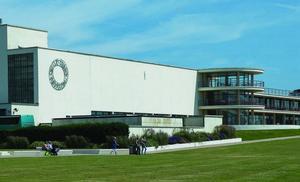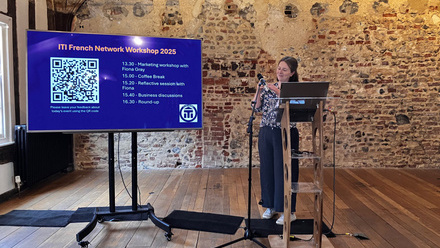Project partners
Kenneth Beattie talks about how working with agencies helped him turn his first career as an architect into a major specialism for his current work
In terms of the subject material you translate, my experience is that working with agencies can be a bit hit-and-miss. Even if the agency has you in its database as a specialist in X, Y and Z, the projects landing in the inbox are often only very tenuously related to the specialisms you’ve cited. Occasionally, though, some great chemistry happens and one successful job leads to repeat work which takes you off on a new journey. And recently, I’ve been exploring how to make this more focused, and use agency work as a way to develop and consolidate my existing translation specialism.
I have been working as a technical translator since 2003 and have thoroughly enjoyed the many excursions I have had into different areas, but in recent times I have been trying to ‘get back to my roots’ and see if I could combine my previous life in architecture with my current one in translation.

The De La Warr Pavilion is a fabulous example of modern seaside architecture.
When I started out in translation, I couldn’t really see the connection between the two careers, but as time went on, my confidence grew and I started to see how I might be able to reconcile them. After all, I had always quietly kept in touch with architecture over the years: reading journals, sketching out designs on my drawing board, studying the designs of my favourite architects or simply sitting in the cafe at the De La Warr Pavilion – a fabulous example of modern seaside architecture and the first of its kind to be built in the UK (in Bexhill-on-Sea), about five minutes from where I used to live. A few years ago, while I was working out my strategy for finding more rewarding work and new customers in my specialism, and working through ITI’s Advancing your Freelance Translation Career (AFT) course, my thoughts turned to how I could use my existing agency customer base as a springboard for this.
A mutually beneficial relationship with agencies
There’s a lot of discussion about whether to work with translation agencies or with direct clients, and for good reason – especially when it comes to rates, since it’s possible to charge direct customers much more. My feeling is that a good relationship with an agency is well worth nurturing because it can lead to a steady supply of repeat work from one or several end customers, and therefore provide financial stability – in my case, for many years. I worked in a translation agency in Germany for six years, from ‘tea boy’ to ‘team leader’, at a multilingual translation and localisation project for a premium automobile manufacturer based in Bavaria. This gave me valuable insights into how agencies work – including how decisions and planning affect results, and the importance of details in planning workflow.
One project manager I had a good working relationship with moved to a company that makes acoustic insulation products, which became my first direct customer when she got back in touch about a year later to ask me to translate the company website. Another is now a technical writer and friend who helps me write my German marketing materials. In a slightly different context, two colleagues in a team I once managed became friends and then set up a graphic design agency, and helped me with layout problems for an article I translated for a construction journal last year.
At another agency, the translations I did over a number of years were well received by the end customer, a company that makes entrance systems, door and window hardware and façade solutions.
So, leaving rates aside for a second, agencies – and more importantly the staff who work in them – can be wonderful business partners. By the time I decided to focus on developing my new specialism, I already had quite a few projects/customers in this or related fields under my belt. I started by obtaining referrals for those. The next step was to increase the number of projects, gain more insights and make more money... so I started a dialogue with a few agencies, hoping that they would send some of the right material my way.
Identifying the market and the people to target
There is one central problem in targeting the ‘architecture’ translation market: it doesn’t really exist as a specific area. On the other hand, if you break down the term ‘architecture’, it potentially encompasses a huge range of topics to do with the built environment, ranging from materials and components, transportation and logistics, to socio-cultural aspects, impact on nature, and more. In addition, I already had some experience of the translation market for products which were clearly designed with architectural concepts in mind (sliding doors designed to be flush with the floor, blurring the distinction between the indoor and outdoor space, and parallel-projecting windows, which are also very popular with architects because they preserve the design integrity of the façade). So that was definitely something to work with.
The AFT course stressed the importance of identifying who does what in the agencies you work with and the ones you want to target. I already had quite a good rapport with the ‘partner manager’ at one agency and we were connected on a number of social media platforms, so I decided one day to go one step further and pick up the phone. Although the agency paid less than a direct customer, it was very good at acquiring new customers and could potentially put some interesting work in front of me.
I let her know I was starting to specialise more in architecture and building, and I asked if it would be possible to send projects ‘related to architecture’, knowing that this could be interpreted in many ways. The outcome of the discussion was very positive, and I waited to see what kind of projects would come along.
The first few projects were small and the subject areas were not quite what I had in mind. There was some discussion about terminology in one interior design project which I felt was not quite right but had already been agreed with the end customer – a problem pretty well all translators have encountered at some point, I suspect. Another larger project was more about external elements, such as gates and fencing systems – a very enjoyable piece of work because of all the technical and design aspects, but lacking the ‘building/construction’ aspect.
A test well worth investing in
And then a paid translation test came along. Some agencies don’t pay for tests and, to be honest, when I saw the text I would probably have agreed to do it for nothing, simply because the subject was very close to my heart. As things turned out it would have been a worthwhile investment anyway. I had been studying how the construction industry is decarbonising and developing sustainable approaches to building, as well as the aesthetics of the materials used and the planning and design considerations involved. The test translation was a press release about a new high-rise apartment building in a riverside location in Amsterdam – made of wood.
Later that year, towards the end of November, the agency got back in touch again with an assignment job for the same customer: this time it was a Christmas card, accompanied by a message in the accompanying email to the effect ‘they chose you’. I spent a very enjoyable hour or so translating the short text, feeling all warm, Christmassy and woozy and sent it back.
About a week later, at the start of December, I was asked if I could translate the company’s entire website.
Landing the dream (at Christmas time)
I was surprised, to put it mildly. I had landed quite a big fish – here it was right in front of me, a dream job. The website was not just beautiful in terms of the architecture portrayed (we architects like pretty pictures!), but also the style and range of texts, not to mention technical topics that I found fascinating. It was so up my street it was uncanny. At the same time, it was a scary one as well.
The job was daunting because of the volume and, despite my insider knowledge, it was still going to push me to my limits. Time was tight too: the customer wanted it as close as possible to the start of 2023, and there wasn’t much leeway. On top of that, I already had plenty on the go and couldn’t start for 10 days. This included a large, highly technical article for a direct customer (in the field of civil engineering), for which I definitely didn’t want to cut corners. To add to the general pressure, my partner and I had just brought an eight-week-old Airedale puppy into our lives – so there was likely to be some distraction and certainly some nights standing outside on the end of a lead shivering in my boxers in the middle of December. And then Christmas was looming. I had to prepare my loved ones for the fact that they might be seeing a bit less of me over the festive period... It was still a no-brainer. Within 10 minutes I had written back to accept.
Fast-forward to the fourth of January: it was delivery day and I had managed to get two extra days, which gave me some valuable time to make checks and send a few queries. I had built a list of around 400 terms, many of which were under review right up until the last minute. The project had been a delight to translate, a fascinating tour of the company, its values and history from its beginnings as a carpentry firm in the 1970s through to international construction firm. It showcased many reference projects spanning educational, retail, commercial, industrial and residential uses. There was also an in-depth study of the high-rise tower, the apotheosis of the company values, a case study in environmentally friendly construction and sustainable living in the heart of a city, innovative and largely prefabricated off-site using construction methods and logistics that were designed to minimise embodied carbon. The thread of sustainability was woven through the whole website. The hybrid timber high-rise building in the heart of Amsterdam, a place where sustainability goes hand in hand with architectural innovation, symbolised the breakthrough of this timber specialist onto the international scene.
My initial test translation represented a small yet memorable milestone for me, the hybrid ‘architectranslator’, which led to what will undoubtedly be one of the highlights of my translation career – and another surprise, and the clearest indication yet that the stars had aligned in this successful collaboration, came a couple of weeks later in the form of unexpected feedback saying ‘it was a pleasure to work on the project’. My specialism and the way I’ve gone about it is definitely paying off.
Never miss another Bulletin article

If you would like to read more features and articles on a wide variety of subjects relating to all aspects of the translation and interpreting industry, subscribe to ITI Bulletin. Alternatively, join ITI and get a free subscription included in your membership.






